The Branding strategy 化妆品品牌营销策划战略研究
- 格式:pdf
- 大小:690.25 KB
- 文档页数:9
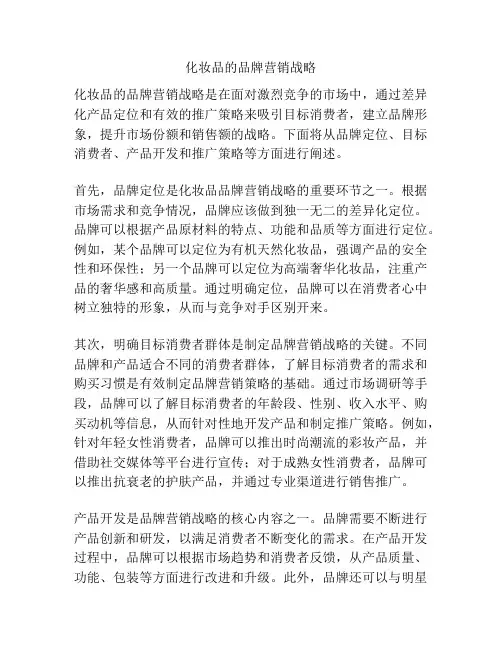
化妆品的品牌营销战略化妆品的品牌营销战略是在面对激烈竞争的市场中,通过差异化产品定位和有效的推广策略来吸引目标消费者,建立品牌形象,提升市场份额和销售额的战略。
下面将从品牌定位、目标消费者、产品开发和推广策略等方面进行阐述。
首先,品牌定位是化妆品品牌营销战略的重要环节之一。
根据市场需求和竞争情况,品牌应该做到独一无二的差异化定位。
品牌可以根据产品原材料的特点、功能和品质等方面进行定位。
例如,某个品牌可以定位为有机天然化妆品,强调产品的安全性和环保性;另一个品牌可以定位为高端奢华化妆品,注重产品的奢华感和高质量。
通过明确定位,品牌可以在消费者心中树立独特的形象,从而与竞争对手区别开来。
其次,明确目标消费者群体是制定品牌营销战略的关键。
不同品牌和产品适合不同的消费者群体,了解目标消费者的需求和购买习惯是有效制定品牌营销策略的基础。
通过市场调研等手段,品牌可以了解目标消费者的年龄段、性别、收入水平、购买动机等信息,从而针对性地开发产品和制定推广策略。
例如,针对年轻女性消费者,品牌可以推出时尚潮流的彩妆产品,并借助社交媒体等平台进行宣传;对于成熟女性消费者,品牌可以推出抗衰老的护肤产品,并通过专业渠道进行销售推广。
产品开发是品牌营销战略的核心内容之一。
品牌需要不断进行产品创新和研发,以满足消费者不断变化的需求。
在产品开发过程中,品牌可以根据市场趋势和消费者反馈,从产品质量、功能、包装等方面进行改进和升级。
此外,品牌还可以与明星合作,推出明星限量款产品,增加品牌的知名度和吸引力。
推广策略是品牌营销战略的重要组成部分。
品牌可以通过多种推广渠道来宣传产品和建立品牌形象。
例如,可以通过电视广告、杂志广告、户外广告等传统媒体进行推广,同时也可以运用新媒体平台如微博、微信、抖音等进行线上推广。
此外,品牌还可以通过举办化妆培训班、参展展会等形式进行线下推广,增加与消费者的互动和接触机会。
综上所述,化妆品的品牌营销战略应该考虑品牌定位、目标消费者、产品开发和推广策略等方面。
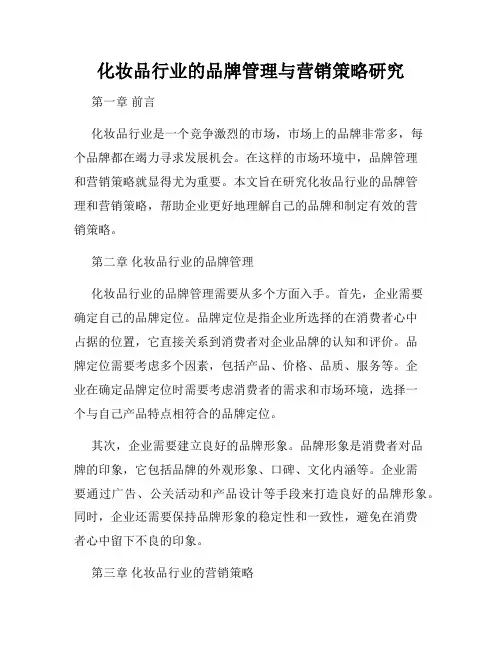
化妆品行业的品牌管理与营销策略研究第一章前言化妆品行业是一个竞争激烈的市场,市场上的品牌非常多,每个品牌都在竭力寻求发展机会。
在这样的市场环境中,品牌管理和营销策略就显得尤为重要。
本文旨在研究化妆品行业的品牌管理和营销策略,帮助企业更好地理解自己的品牌和制定有效的营销策略。
第二章化妆品行业的品牌管理化妆品行业的品牌管理需要从多个方面入手。
首先,企业需要确定自己的品牌定位。
品牌定位是指企业所选择的在消费者心中占据的位置,它直接关系到消费者对企业品牌的认知和评价。
品牌定位需要考虑多个因素,包括产品、价格、品质、服务等。
企业在确定品牌定位时需要考虑消费者的需求和市场环境,选择一个与自己产品特点相符合的品牌定位。
其次,企业需要建立良好的品牌形象。
品牌形象是消费者对品牌的印象,它包括品牌的外观形象、口碑、文化内涵等。
企业需要通过广告、公关活动和产品设计等手段来打造良好的品牌形象。
同时,企业还需要保持品牌形象的稳定性和一致性,避免在消费者心中留下不良的印象。
第三章化妆品行业的营销策略化妆品行业的营销策略需要从以下几个方面入手。
首先,企业需要选择适当的市场定位。
市场定位是指企业在市场中所选择的竞争地位和目标客户群。
企业需要根据自己的产品特点和目标客户群来选择适当的市场定位,以便更好地开展营销活动。
其次,企业需要建立多元化的营销渠道。
化妆品是广泛应用于各类人群的产品,因此企业需要通过不同的销售渠道来满足不同层次客户的需求。
除了传统的实体店铺销售模式外,企业还可以通过互联网销售、直播带货等新型销售模式来扩大销售渠道。
第四章化妆品行业的品牌管理与营销策略案例分析1.兰蔻兰蔻是一家法国化妆品品牌,其品牌定位是奢华、高端,专业面向中高端消费者。
兰蔻在品牌形象上注重奢华感和时尚感,使用名人代言和爆炸式广告等手段来提升品牌知名度。
在营销策略上,兰蔻通过精准的市场定位和高品质的产品来巩固自己的品牌地位。
同时,兰蔻在全球范围内建立了完整的供应链体系和销售网络,通过多元化渠道来满足不同消费者群体的需求。
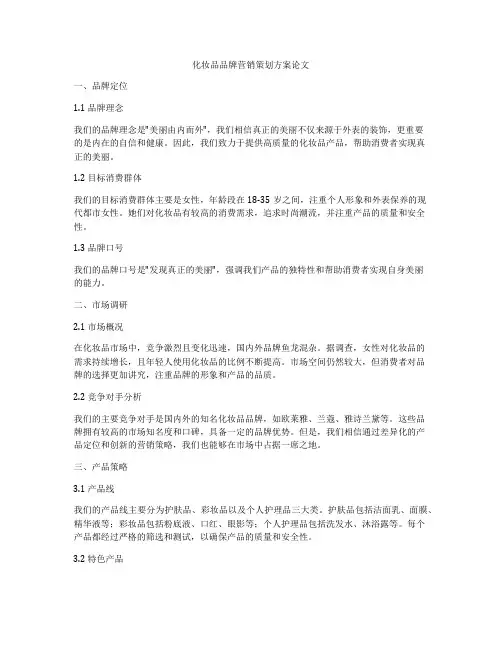
化妆品品牌营销策划方案论文一、品牌定位1.1 品牌理念我们的品牌理念是"美丽由内而外",我们相信真正的美丽不仅来源于外表的装饰,更重要的是内在的自信和健康。
因此,我们致力于提供高质量的化妆品产品,帮助消费者实现真正的美丽。
1.2 目标消费群体我们的目标消费群体主要是女性,年龄段在18-35岁之间,注重个人形象和外表保养的现代都市女性。
她们对化妆品有较高的消费需求,追求时尚潮流,并注重产品的质量和安全性。
1.3 品牌口号我们的品牌口号是"发现真正的美丽",强调我们产品的独特性和帮助消费者实现自身美丽的能力。
二、市场调研2.1 市场概况在化妆品市场中,竞争激烈且变化迅速,国内外品牌鱼龙混杂。
据调查,女性对化妆品的需求持续增长,且年轻人使用化妆品的比例不断提高。
市场空间仍然较大,但消费者对品牌的选择更加讲究,注重品牌的形象和产品的品质。
2.2 竞争对手分析我们的主要竞争对手是国内外的知名化妆品品牌,如欧莱雅、兰蔻、雅诗兰黛等。
这些品牌拥有较高的市场知名度和口碑,具备一定的品牌优势。
但是,我们相信通过差异化的产品定位和创新的营销策略,我们也能够在市场中占据一席之地。
三、产品策略3.1 产品线我们的产品线主要分为护肤品、彩妆品以及个人护理品三大类。
护肤品包括洁面乳、面膜、精华液等;彩妆品包括粉底液、口红、眼影等;个人护理品包括洗发水、沐浴露等。
每个产品都经过严格的筛选和测试,以确保产品的质量和安全性。
3.2 特色产品在产品线中,我们将推出一系列的特色产品,以增加产品的独特性和竞争力。
例如,推出针对不同肤质的特殊护肤产品、使用天然成分的环保彩妆产品等。
我们也将与美容院合作,推出专业级的护肤产品,满足消费者个性化的需求。
四、价格策略4.1 定价方式我们的产品价格将根据市场需求和竞争对手的定价进行灵活调整。
在品质保证的前提下,我们将尽可能提供合理的价格,以吸引消费者的购买。
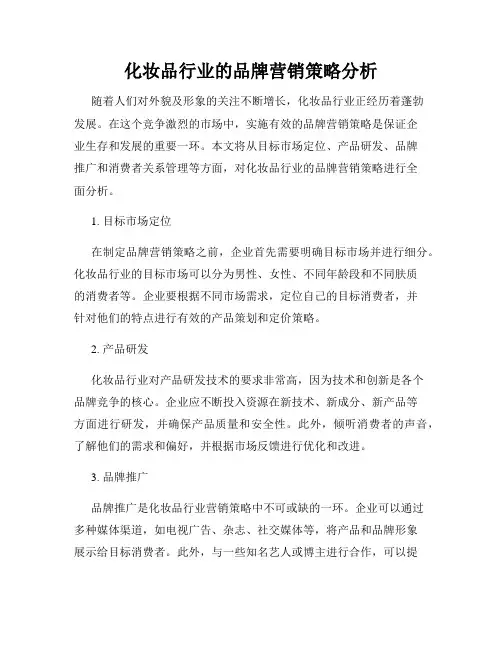
化妆品行业的品牌营销策略分析随着人们对外貌及形象的关注不断增长,化妆品行业正经历着蓬勃发展。
在这个竞争激烈的市场中,实施有效的品牌营销策略是保证企业生存和发展的重要一环。
本文将从目标市场定位、产品研发、品牌推广和消费者关系管理等方面,对化妆品行业的品牌营销策略进行全面分析。
1. 目标市场定位在制定品牌营销策略之前,企业首先需要明确目标市场并进行细分。
化妆品行业的目标市场可以分为男性、女性、不同年龄段和不同肤质的消费者等。
企业要根据不同市场需求,定位自己的目标消费者,并针对他们的特点进行有效的产品策划和定价策略。
2. 产品研发化妆品行业对产品研发技术的要求非常高,因为技术和创新是各个品牌竞争的核心。
企业应不断投入资源在新技术、新成分、新产品等方面进行研发,并确保产品质量和安全性。
此外,倾听消费者的声音,了解他们的需求和偏好,并根据市场反馈进行优化和改进。
3. 品牌推广品牌推广是化妆品行业营销策略中不可或缺的一环。
企业可以通过多种媒体渠道,如电视广告、杂志、社交媒体等,将产品和品牌形象展示给目标消费者。
此外,与一些知名艺人或博主进行合作,可以提升品牌的知名度和影响力。
但需要注意的是,品牌推广活动要与目标市场的特点和趋势相符合,并传递出与品牌定位相符的信息。
4. 消费者关系管理消费者关系管理是建立和维护忠诚客户的关键。
化妆品企业可以通过提供优质的购物体验、售后服务以及积极回应客户的反馈和建议来增强消费者对品牌的忠诚度。
此外,参与公益活动、开展会员制度等也可以增加消费者的粘性。
总结而言,化妆品行业的品牌营销策略需要在目标市场定位、产品研发、品牌推广和消费者关系管理等方面取得平衡。
企业应根据市场需求和竞争情况进行不断创新和调整,以求在竞争激烈的市场中立于不败之地。
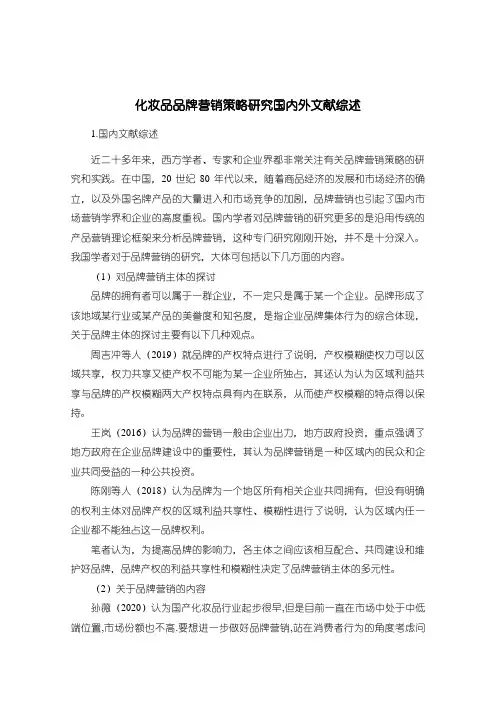
化妆品品牌营销策略研究国内外文献综述1.国内文献综述近二十多年来,西方学者、专家和企业界都非常关注有关品牌营销策略的研究和实践。
在中国,20 世纪80 年代以来,随着商品经济的发展和市场经济的确立,以及外国名牌产品的大量进入和市场竞争的加剧,品牌营销也引起了国内市场营销学界和企业的高度重视。
国内学者对品牌营销的研究更多的是沿用传统的产品营销理论框架来分析品牌营销,这种专门研究刚刚开始,并不是十分深入。
我国学者对于品牌营销的研究,大体可包括以下几方面的内容。
(1)对品牌营销主体的探讨品牌的拥有者可以属于一群企业,不一定只是属于某一个企业。
品牌形成了该地域某行业或某产品的美誉度和知名度,是指企业品牌集体行为的综合体现,关于品牌主体的探讨主要有以下几种观点。
周吉冲等人(2019)就品牌的产权特点进行了说明,产权模糊使权力可以区域共享,权力共享又使产权不可能为某一企业所独占,其还认为认为区域利益共享与品牌的产权模糊两大产权特点具有内在联系,从而使产权模糊的特点得以保持。
王岚(2016)认为品牌的营销一般由企业出力,地方政府投资,重点强调了地方政府在企业品牌建设中的重要性,其认为品牌营销是一种区域内的民众和企业共同受益的一种公共投资。
陈刚等人(2018)认为品牌为一个地区所有相关企业共同拥有,但没有明确的权利主体对品牌产权的区域利益共享性、模糊性进行了说明,认为区域内任一企业都不能独占这一品牌权利。
笔者认为,为提高品牌的影响力,各主体之间应该相互配合、共同建设和维护好品牌,品牌产权的利益共享性和模糊性决定了品牌营销主体的多元性。
(2)关于品牌营销的内容孙薇(2020)认为国产化妆品行业起步很早,但是目前一直在市场中处于中低端位置,市场份额也不高.要想进一步做好品牌营销,站在消费者行为的角度考虑问题至关重要.王煦涵和刘颖昕(2020)认为品牌营销是企业品牌的塑造、使用和维护的过程,是在分析外部条件和自身条件的基础上所制定的企业行动计划,现阶段随着市场经济的发展,企业之间的竞争更加激烈,品牌营销的重要性凸显,企业经营者要抓住机遇、审时度势,适时进行品牌营销。
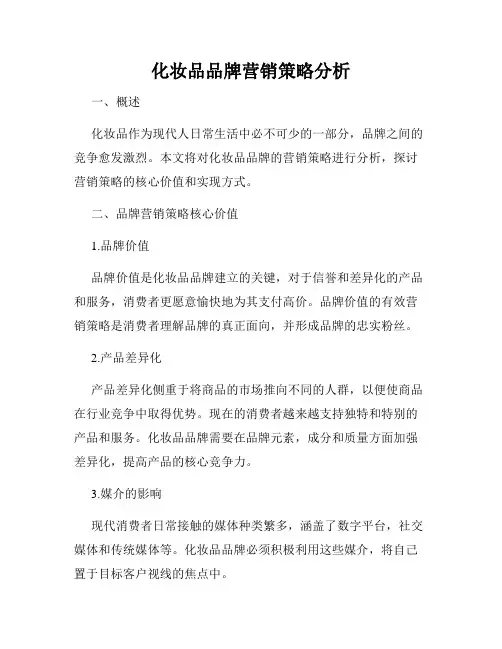
化妆品品牌营销策略分析一、概述化妆品作为现代人日常生活中必不可少的一部分,品牌之间的竞争愈发激烈。
本文将对化妆品品牌的营销策略进行分析,探讨营销策略的核心价值和实现方式。
二、品牌营销策略核心价值1.品牌价值品牌价值是化妆品品牌建立的关键,对于信誉和差异化的产品和服务,消费者更愿意愉快地为其支付高价。
品牌价值的有效营销策略是消费者理解品牌的真正面向,并形成品牌的忠实粉丝。
2.产品差异化产品差异化侧重于将商品的市场推向不同的人群,以便使商品在行业竞争中取得优势。
现在的消费者越来越支持独特和特别的产品和服务。
化妆品品牌需要在品牌元素,成分和质量方面加强差异化,提高产品的核心竞争力。
3.媒介的影响现代消费者日常接触的媒体种类繁多,涵盖了数字平台,社交媒体和传统媒体等。
化妆品品牌必须积极利用这些媒介,将自己置于目标客户视线的焦点中。
三、品牌营销策略实现方式1.持续的客户关系管理创建和维护客户关系需要根据不同的阶段分类实施不同的策略。
在化妆品品牌中,客户关系主要分为试用,购买后服务,复购和品牌忠诚度四个阶段。
通过积极管理每个阶段的过程,品牌将可以增强客户的忠诚度并获得更多的口碑支持。
2.有效的数字营销现代化妆品品牌必须将每个可能的数字媒体进行整合,以完善其市场营销策略。
有针对性的广告,搜索引擎优化,社交媒体营销和电子邮件必须与创造品牌声誉的内容一起使用。
3.以客户为中心的产品设计现代消费者越来越体现个性化和差异化,化妆品品牌必须通过改进和价值创造以满足这种需求变化。
有针对性的研究和开发可以帮助品牌创建以消费者为中心的产品和服务,并加强品牌差异化。
4.利用生命周期营销生命周期营销是一种针对消费者生命周期不同阶段的广告和促销策略。
在化妆品市场,生命周期营销中的典型阶段包括试用,购买,使用,复购和维护。
利用生命周期营销策略可以提高品牌的知名度和忠诚度,同时在竞争中积攒优势。
四、结论化妆品市场的竞争日趋激烈,品牌需要在价值和实现方式方面加强策略。
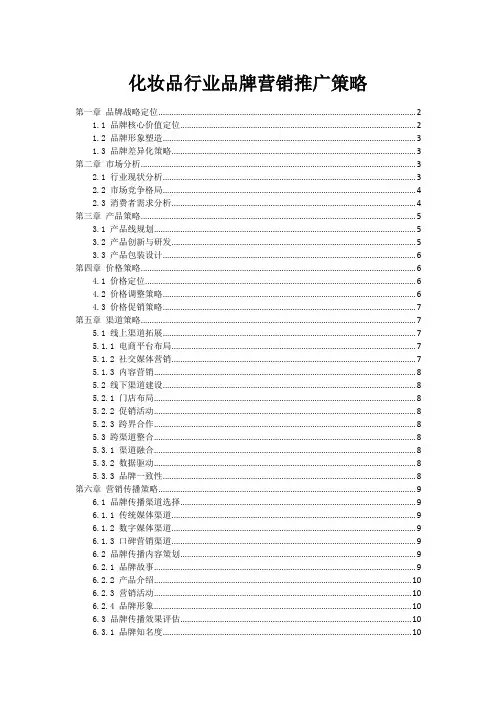
化妆品行业品牌营销推广策略第一章品牌战略定位 (2)1.1 品牌核心价值定位 (2)1.2 品牌形象塑造 (3)1.3 品牌差异化策略 (3)第二章市场分析 (3)2.1 行业现状分析 (3)2.2 市场竞争格局 (4)2.3 消费者需求分析 (4)第三章产品策略 (5)3.1 产品线规划 (5)3.2 产品创新与研发 (5)3.3 产品包装设计 (6)第四章价格策略 (6)4.1 价格定位 (6)4.2 价格调整策略 (6)4.3 价格促销策略 (7)第五章渠道策略 (7)5.1 线上渠道拓展 (7)5.1.1 电商平台布局 (7)5.1.2 社交媒体营销 (7)5.1.3 内容营销 (8)5.2 线下渠道建设 (8)5.2.1 门店布局 (8)5.2.2 促销活动 (8)5.2.3 跨界合作 (8)5.3 跨渠道整合 (8)5.3.1 渠道融合 (8)5.3.2 数据驱动 (8)5.3.3 品牌一致性 (8)第六章营销传播策略 (9)6.1 品牌传播渠道选择 (9)6.1.1 传统媒体渠道 (9)6.1.2 数字媒体渠道 (9)6.1.3 口碑营销渠道 (9)6.2 品牌传播内容策划 (9)6.2.1 品牌故事 (9)6.2.2 产品介绍 (10)6.2.3 营销活动 (10)6.2.4 品牌形象 (10)6.3 品牌传播效果评估 (10)6.3.1 品牌知名度 (10)6.3.2 品牌美誉度 (10)6.3.3 销售业绩 (10)6.3.4 品牌忠诚度 (10)6.3.5 品牌传播成本 (10)第七章社交媒体营销 (10)7.1 社交媒体平台选择 (10)7.2 社交媒体内容创意 (11)7.3 社交媒体营销效果分析 (11)第八章促销活动策划 (12)8.1 促销活动类型 (12)8.2 促销活动策划流程 (12)8.3 促销活动效果评估 (12)第九章公关策略 (13)9.1 公关活动策划 (13)9.1.1 活动主题设定 (13)9.1.2 活动形式与内容 (13)9.1.3 活动策划执行 (13)9.2 危机公关处理 (14)9.2.1 危机预警 (14)9.2.2 危机应对策略 (14)9.2.3 危机后续处理 (14)9.3 企业社会责任 (14)9.3.1 社会责任理念 (14)9.3.2 环保责任 (14)9.3.3 员工权益 (15)9.3.4 消费者权益 (15)第十章客户关系管理 (15)10.1 客户信息收集与管理 (15)10.2 客户满意度提升 (15)10.3 客户忠诚度培养 (16)第一章品牌战略定位1.1 品牌核心价值定位消费市场的日益成熟,化妆品行业竞争愈发激烈。
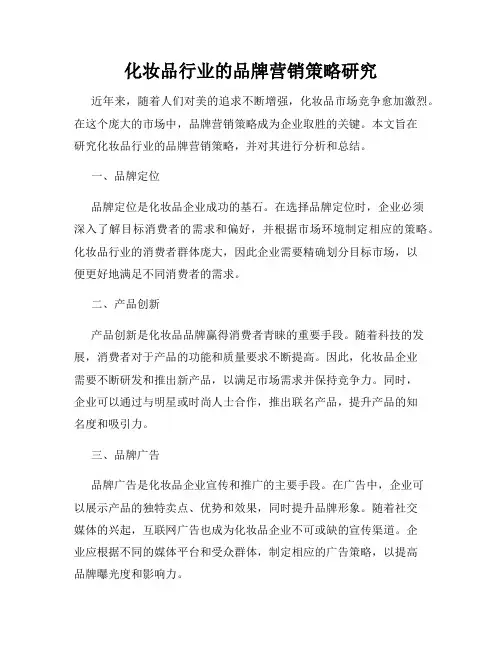
化妆品行业的品牌营销策略研究近年来,随着人们对美的追求不断增强,化妆品市场竞争愈加激烈。
在这个庞大的市场中,品牌营销策略成为企业取胜的关键。
本文旨在研究化妆品行业的品牌营销策略,并对其进行分析和总结。
一、品牌定位品牌定位是化妆品企业成功的基石。
在选择品牌定位时,企业必须深入了解目标消费者的需求和偏好,并根据市场环境制定相应的策略。
化妆品行业的消费者群体庞大,因此企业需要精确划分目标市场,以便更好地满足不同消费者的需求。
二、产品创新产品创新是化妆品品牌赢得消费者青睐的重要手段。
随着科技的发展,消费者对于产品的功能和质量要求不断提高。
因此,化妆品企业需要不断研发和推出新产品,以满足市场需求并保持竞争力。
同时,企业可以通过与明星或时尚人士合作,推出联名产品,提升产品的知名度和吸引力。
三、品牌广告品牌广告是化妆品企业宣传和推广的主要手段。
在广告中,企业可以展示产品的独特卖点、优势和效果,同时提升品牌形象。
随着社交媒体的兴起,互联网广告也成为化妆品企业不可或缺的宣传渠道。
企业应根据不同的媒体平台和受众群体,制定相应的广告策略,以提高品牌曝光度和影响力。
四、线上销售渠道随着电子商务的快速发展,线上销售渠道正逐渐成为化妆品企业的重要销售方式。
企业可以通过自营电商平台或合作电商平台,将产品直接销售给消费者。
此外,企业还可以通过与社交媒体KOL合作,进行产品推广和销售。
线上销售渠道的出现不仅增加了企业的销售机会,还提供了更便捷的购物体验,满足了现代消费者的需求。
五、品牌口碑品牌口碑对于化妆品企业来说至关重要。
消费者对于化妆品的选择往往会受到他人的推荐和评价的影响。
因此,企业需要注重产品的质量和服务质量,积极回应消费者的疑虑和问题,树立良好的品牌形象。
同时,通过积极参与公益活动和社会责任,企业可以赢得更多消费者的认可,并提升品牌口碑。
六、市场数据分析市场数据分析是企业制定品牌营销策略时的基础。
企业需要定期收集和分析市场数据,了解市场趋势、竞争对手的动态和消费者的需求变化。
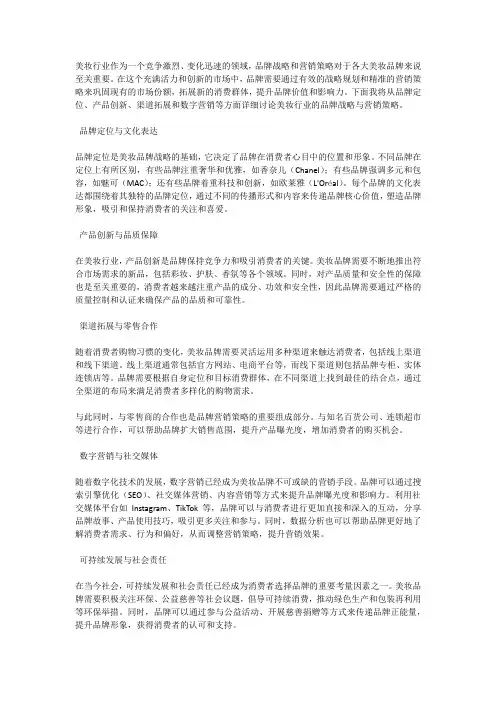
美妆行业作为一个竞争激烈、变化迅速的领域,品牌战略和营销策略对于各大美妆品牌来说至关重要。
在这个充满活力和创新的市场中,品牌需要通过有效的战略规划和精准的营销策略来巩固现有的市场份额,拓展新的消费群体,提升品牌价值和影响力。
下面我将从品牌定位、产品创新、渠道拓展和数字营销等方面详细讨论美妆行业的品牌战略与营销策略。
品牌定位与文化表达品牌定位是美妆品牌战略的基础,它决定了品牌在消费者心目中的位置和形象。
不同品牌在定位上有所区别,有些品牌注重奢华和优雅,如香奈儿(Chanel);有些品牌强调多元和包容,如魅可(MAC);还有些品牌着重科技和创新,如欧莱雅(L'Oréal)。
每个品牌的文化表达都围绕着其独特的品牌定位,通过不同的传播形式和内容来传递品牌核心价值,塑造品牌形象,吸引和保持消费者的关注和喜爱。
产品创新与品质保障在美妆行业,产品创新是品牌保持竞争力和吸引消费者的关键。
美妆品牌需要不断地推出符合市场需求的新品,包括彩妆、护肤、香氛等各个领域。
同时,对产品质量和安全性的保障也是至关重要的,消费者越来越注重产品的成分、功效和安全性,因此品牌需要通过严格的质量控制和认证来确保产品的品质和可靠性。
渠道拓展与零售合作随着消费者购物习惯的变化,美妆品牌需要灵活运用多种渠道来触达消费者,包括线上渠道和线下渠道。
线上渠道通常包括官方网站、电商平台等,而线下渠道则包括品牌专柜、实体连锁店等。
品牌需要根据自身定位和目标消费群体,在不同渠道上找到最佳的结合点,通过全渠道的布局来满足消费者多样化的购物需求。
与此同时,与零售商的合作也是品牌营销策略的重要组成部分。
与知名百货公司、连锁超市等进行合作,可以帮助品牌扩大销售范围,提升产品曝光度,增加消费者的购买机会。
数字营销与社交媒体随着数字化技术的发展,数字营销已经成为美妆品牌不可或缺的营销手段。
品牌可以通过搜索引擎优化(SEO)、社交媒体营销、内容营销等方式来提升品牌曝光度和影响力。
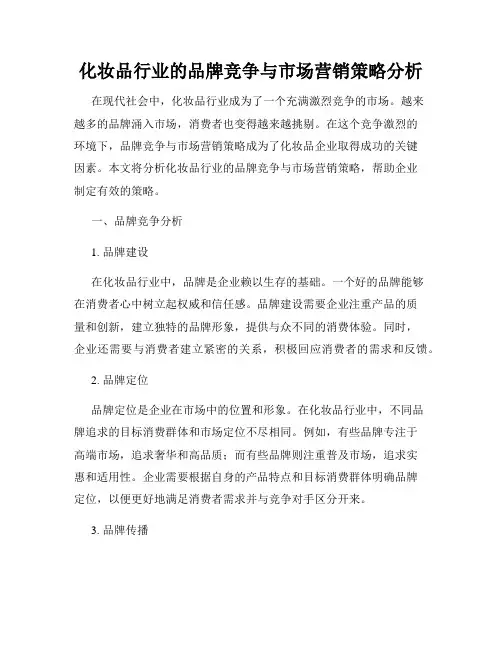
化妆品行业的品牌竞争与市场营销策略分析在现代社会中,化妆品行业成为了一个充满激烈竞争的市场。
越来越多的品牌涌入市场,消费者也变得越来越挑剔。
在这个竞争激烈的环境下,品牌竞争与市场营销策略成为了化妆品企业取得成功的关键因素。
本文将分析化妆品行业的品牌竞争与市场营销策略,帮助企业制定有效的策略。
一、品牌竞争分析1. 品牌建设在化妆品行业中,品牌是企业赖以生存的基础。
一个好的品牌能够在消费者心中树立起权威和信任感。
品牌建设需要企业注重产品的质量和创新,建立独特的品牌形象,提供与众不同的消费体验。
同时,企业还需要与消费者建立紧密的关系,积极回应消费者的需求和反馈。
2. 品牌定位品牌定位是企业在市场中的位置和形象。
在化妆品行业中,不同品牌追求的目标消费群体和市场定位不尽相同。
例如,有些品牌专注于高端市场,追求奢华和高品质;而有些品牌则注重普及市场,追求实惠和适用性。
企业需要根据自身的产品特点和目标消费群体明确品牌定位,以便更好地满足消费者需求并与竞争对手区分开来。
3. 品牌传播品牌传播是提升品牌知名度和美誉度的关键环节。
在当今数字时代,企业可以利用多种渠道进行品牌传播,如社交媒体、电视广告、明星代言等。
通过选择合适的传播渠道和方式,企业可以有效地将品牌形象和产品信息传递给目标消费群体,建立品牌认知和好感度。
二、市场营销策略分析1. 目标市场分析在制定市场营销策略时,首先需要明确目标市场。
消费者的需求和偏好因地区、年龄、性别等因素而异,企业需要根据目标市场的特点,精确定位产品定价、推广和销售渠道。
例如,一些企业根据不同地区的文化特点和消费观念,开发相应的产品系列和推广活动,以满足不同市场的需求。
2. 产品策略产品策略是市场营销的核心。
企业需要根据目标市场的需求,提供具有差异化和附加值的产品。
在化妆品行业中,产品的质量、功效和与消费者需求的契合度是至关重要的因素。
同时,产品创新也是提升竞争力的关键要素,可通过引入新的成分、推出独特的包装设计等方式进行。

化妆品行业的品牌营销策略化妆品行业是一个竞争激烈的市场。
每个品牌都致力于让自己在行业中脱颖而出。
品牌营销策略是成功的关键之一。
在这篇文章中,我们将讨论化妆品行业的品牌营销策略。
首先,品牌定位是品牌营销的关键。
品牌定位决定了你的品牌在消费者心中的形象。
化妆品品牌通常分为高端品牌、中档品牌和平价品牌。
高端品牌的价格昂贵,追求品味和奢华感,比如雅诗兰黛,迪奥等;中档品牌主要定位于平易近人、质量价格比高的消费者(如Lancome、阿芙等);而平价品牌主要致力于追求优质产品的亲民群体(如L'Oreal Paris、Maybelline等)。
品牌定位要与目标消费者群体相匹配,以确保成功。
其次,品牌包装设计是吸引消费者注意力的重要元素。
化妆品市场竞争激烈,因此要通过包装设计来吸引消费者的注意力和激发购买欲望。
化妆品的包装设计需要综合考虑品牌定位、消费者喜好和手感设计等多重因素,制作出独具特色的包装设计。
如纪梵希以黑色包装设计为标志,杜嘉班纳以鞍形状包装设计为经典形象,蝉花以独特的花瓣造型吸引视线等。
第三,品牌推广策略也是品牌营销策略不可或缺的一部分。
品牌推广有很多种形式,包括广告、促销、展会、赞助等。
广告是最常用的品牌推广手段,可通过电视、互联网社交媒体和杂志等传媒形式向广大消费者宣传品牌。
促销则可通过打折促销、赠品促销甚至限量版等,吸引消费者购买品牌。
展会和赞助则是其他品牌推广策略的重要元素,可通过参加各种展会活动或赞助形式吸引消费者注意,增强品牌信誉度。
最后,品牌口碑构建也是重要的品牌营销策略之一。
通过多种渠道和方式获得客户的良好体验并形成积极的口碑,是建立品牌信誉度的重要手段。
口碑营销的高效方式包括宣传推广、在线社区、用户评价和客户服务等。
总之,品牌营销策略是化妆品行业取得成功的关键所在。
在团队初期时,要根据品牌定位、包装设计、推广策略和口碑构建等元素,制定符合品牌特色的成功营销计划,并在销售中跟踪评估执行效果。
化妆品品牌的市场营销策略化妆品作为女性日常生活必需品,其市场已经越来越庞大。
随着消费者对品质、效果的要求不断提高,化妆品品牌竞争愈加激烈。
因此,科学有效的营销策略对于不同类型的品牌来说至关重要。
本文将就化妆品品牌的市场营销策略进行讨论。
一、定位策略品牌的定位策略是市场营销的核心之一,定位策略直接决定了品牌是否能成功地建立客户基础。
品牌定位策略与市场定位密切相关。
化妆品品牌通常会对不同的客户群体进行市场定位。
例如对于年轻女性,品牌通常推出可爱的包装与质量更为适宜的低价产品。
但是对于年龄较大的成年女性,品牌需要推出更为高端的产品,并注重功能性。
在定位方面,是否准确地把握目标客户群体、准确地把握市场定位至关重要。
二、产品创新策略作为一种日用品,化妆品品牌需要不断更新自己的产品,以适应市场变化。
同时,品牌需要通过更多的投资去支持研究和开发,从而保持产品的领先性。
化妆品品牌在产品创新方面投入非常大的精力和资金。
例如一些品牌为了创造更为时尚的产品,推出了具有艺术性的产品系列,吸引了一大批更加注重个性和独立性的消费者。
三、品牌形象策略化妆品品牌的形象策略主要是通过广告、包装和宣传等手段来推广,让消费者对于产品形成认可感。
例如一些品牌通过拍摄广告或者在商场中布置漂亮而奢华的展柜,来确立品牌的高端、时尚、优雅等方面的形象。
同时,品牌通过推出知名的代言人或者进行某些公益活动,以提高品牌认知度并打造品牌形象。
品牌形象的塑造需要时刻追求与目标客户群体的需求相匹配,从而创造出具有品牌特色的文化与价值观。
四、品牌扩展策略品牌扩展策略是一种向多元领域拓展的策略,多数化妆品品牌都会通过扩展去推广品牌的文化内涵等。
例如 Estée Lauder基于品牌的准则,推出了Estée Lauder集团品牌下的其他产品线,如Clinique和Bobbi Brown等。
通过扩展可以让消费者更多地了解品牌和品牌文化,同时提高消费者对品牌的忠诚度。
化妆品行业品牌营销策略化妆品行业是一个竞争激烈的市场,品牌营销策略对企业的发展至关重要。
本文将重点探讨化妆品行业品牌营销策略的关键要素和实施方法。
一、建立品牌定位与形象品牌定位是化妆品企业制定品牌营销策略的第一步。
企业需要明确自己的目标消费群体和市场定位,并在此基础上确定品牌形象。
如欧莱雅的“科技领先,美丽无限”,通过科技创新以及丰富的产品线满足不同消费者的需求,在市场中建立了强大的品牌声誉。
二、创新产品开发与研究在化妆品行业,产品是品牌的核心竞争力。
为了获取市场份额,企业需要不断进行产品创新与研发。
例如,兰蔻推出的夏季限量版彩妆产品,通过与知名艺术家合作,以独特设计和丰富色彩吸引年轻消费者,提升品牌在市场中的竞争力。
三、建立线上线下渠道随着互联网的发展,线上渠道成为化妆品品牌营销的重要手段。
企业可以通过电商平台、社交媒体以及官方网站等途径与消费者建立联系。
此外,线下实体店铺仍然是一种重要的销售渠道,可以提供消费者亲身体验和服务。
化妆品企业应该通过线上线下渠道的结合,营造消费者购物的便利性和愉悦感。
四、关注消费者需求和体验消费者需求是一个动态的变化过程,化妆品企业需要时刻关注市场趋势和消费者的反馈。
通过市场调研和数据分析,企业可以更好地了解消费者需求,并及时调整产品和营销策略。
此外,提供良好的购物体验也是提升品牌忠诚度的重要手段。
例如,雅诗兰黛的柜台销售员会为每位顾客提供个性化的咨询和试妆服务,让消费者感受到专业的呵护。
五、建立品牌口碑和社交媒体营销在化妆品行业,品牌口碑至关重要。
通过与知名化妆师、明星代言人和时尚博主的合作,企业可以借助他们的影响力提升品牌的认知度和声誉。
同时,运用社交媒体平台扩大品牌影响力也是重要的营销手段。
通过发布精心制作的内容、与粉丝互动和分享用户体验等方式,企业可以更好地与消费者建立联系。
六、灵活运用促销活动促销活动是化妆品品牌营销策略的重要组成部分。
企业可以通过赠品、限时特惠、打折优惠等方式吸引消费者,激发购买欲望。
化妆品品牌定位与推广策略的研究化妆品作为消费者日常生活中不可或缺的一部分,品牌定位与推广策略显得尤为重要。
化妆品的品牌定位既包括了产品定位、目标消费者群体定位、品牌形象定位等方面,同时也是品牌推广策略的基础。
如何制定合理的化妆品品牌定位和推广策略成为很多化妆品企业关注的问题。
一、品牌定位品牌定位是指企业为了在消费者心目中留下独特地区别于其他品牌的印象而实施的各种活动。
化妆品的品牌定位是一个全方位的策略,需要考虑产品的质量、价格、目标消费者、市场需求等多方面因素,让消费者在选择商品时通过简单的印象或形象能够迅速识别出品牌并且产生延续的购买意愿。
首先,品牌定位需要从产品出发,吸引消费者,满足消费者需求,因此需要有具有自主知识产权的独特产品。
其次,需要在广告语、文案、视觉设计等方面奠定品牌形象基础。
最后,品牌需要根据特定的目标消费者群体定位。
这样才能在消费者心目中留下深刻的印象。
二、推广策略化妆品的推广策略包括整合营销推广、电子商务、网红营销等。
其中,整合营销推广主要包括广告传媒与公关推广。
企业可以使用广告传媒传递品牌形象、品质与产品特色等信息,同时通过公关推广树立企业形象,提升品牌影响力。
电子商务则是化妆品企业必不可少的推广方式,是品牌建设和售卖的重要手段。
通过电子商务平台可以更好地满足消费者的消费需求,提高化妆品产品的销售量,并且可以收集到消费者的销售数据,为消费者提供更好的产品和服务。
与以往相比,网红营销经验丰富,是借助互联网平台和人气网络红人展示产品,果断地吸收消费者关注,提高品牌美誉度和生意。
现在随着全民的互联网入口日渐广泛,网红的力量愈发强大,这种营销方式已成为品牌推广策略的重要手段。
三、化妆品推广策略案例1. MACMAC品牌早期的定位是专业化,针对为化妆师群体供货,为广大女性打造多款高品质、高颜值的化妆品。
为此MAC在产品包装上特别设计出黑色膏状盒子,直接向目标消费群体传递了产品的专业性和高品质的形象。
化妆品行业的品牌策略与市场营销在中国的化妆品行业,市场竞争越来越激烈。
随着消费者需求的不断变化和互联网的快速发展,化妆品企业不仅需要制定适应市场需求的品牌策略,还需要全面营销推广,以吸引更多的消费者。
本文将从品牌策略和市场营销两个方面探讨化妆品行业的发展。
第一章品牌策略品牌是企业核心竞争力的体现。
化妆品企业要想在市场中获得成功,就必须建立一个令消费者认可的品牌。
化妆品品牌策略的目标是提升品牌价值和影响力,增加品牌的知名度和美誉度。
1.区分目标市场化妆品行业的目标市场非常广泛,包括青少年、中年人和老年人等不同年龄段的人。
因此,企业在制定品牌策略时,必须先确定目标市场,以便更好地满足消费者需求。
例如,L'Oreal针对中高档市场,同时推出多个品牌满足不同人群的需求;而雅诗兰黛则着重打造奢华、高端的品牌形象,追求高品质的消费者。
2.品牌形象的塑造品牌形象是品牌策略中非常重要的一环。
企业通过在广告、包装、产品广告等方面的努力来塑造品牌形象。
通过设计独具特色的产品包装和广告语,企业可以激发顾客的购买欲望。
雅诗兰黛的产品包装非常精美,符合女性消费者对美的追求,其广告语“每个女人都值得拥有优雅的体验”也很贴切。
这样的品牌形象不仅传达了品牌和产品的价值,还增加了产品的美誉度。
3.品牌扩张品牌扩张是企业品牌策略的重要组成部分,对企业未来的发展至关重要。
化妆品企业可以通过推出新品牌、新产品、新线并扩展产品或服务种类等方式,促进企业的扩张。
例如,L'Oreal集团推出了多个著名品牌,如卡诗,兰芝和欧莱雅等,成功地实现了品牌扩张。
此外,达芙妮也尝试了品牌扩张,通过推出美容产品、食品等新产品种类来延伸达芙妮品牌的边界和影响力。
第二章市场营销化妆品行业市场竞争激烈,市场营销是企业获得市场份额的主要手段。
化妆品企业通过创新营销策略、全面打造品牌形象等方式来吸引消费者,提升企业市场份额。
1.广告营销广告营销是化妆品企业最常用的一种市场营销方式。
化妆品行业的品牌战略分析在当今日益竞争激烈的化妆品市场中,品牌战略的成功非常关键。
化妆品品牌的成功依赖于其品牌形象、定位、市场营销策略和产品创新等多方面因素。
本文将通过对化妆品行业品牌战略的分析,探讨化妆品品牌取得成功的因素。
一、品牌形象的建立品牌形象的建立是将化妆品品牌与其他品牌区分开来的第一步。
品牌形象是消费者心目中对品牌的印象和信念。
成功的化妆品品牌应该力争在消费者心目中树立良好的形象。
品牌形象由品牌名称、标志、包装、广告和产品质量等多个方面构成。
品牌名称应该简单易记,标志应该简洁明了,产品包装设计应该与品牌形象一致,广告内容应该能够引起消费者兴趣并增强其对品牌的认同感。
二、品牌定位品牌定位是品牌在消费者心目中占据的位置。
品牌定位应该根据消费者的需求和市场竞争情况来确定。
在化妆品市场中,品牌定位通常是基于产品类型、目标市场、产品价格和产品质量来确定的。
在确定品牌定位时,化妆品品牌需要研究目标市场的行为和偏好,并根据消费者的需求开发相应的产品,以便使品牌定位更加明确。
三、市场营销策略市场营销策略是化妆品品牌成功的重要因素之一。
一个成功的品牌应该有一个全面的市场营销策略,这个策略应该符合产品目标市场需求和消费者偏好。
市场营销策略可以包括渠道销售、广告、促销活动、公关和产品创新等方面。
渠道销售是指将产品通过不同的销售渠道推广到消费者,如在化妆品商店、超市和网络平台等出售。
广告可以根据不同的市场需求选择合适的广告媒介和广告内容来进行。
促销活动可以通过降价、赠品和限时优惠等方式来吸引消费者。
公关可以通过与一些社会组织和媒体合作来树立良好的品牌形象。
此外,产品创新对于品牌营销也是至关重要的,通过持续的产品创新和研发,品牌可以获得更多的市场份额。
四、产品质量产品质量是创造化妆品品牌成功的重要因素之一。
消费者会根据产品质量来评价品牌是否可信赖。
品牌应该通过产品质量控制和改进来提高消费者对其产品的信任度和好感度。
THE EFFECTIVENESS OF CORPORATE BRANDING STRATEGY INMULTI-BUSINESS COMPANIESMasume Hosseinzadeh ShahriFaculty member of Business Management Department,Alzahra University, IRANE-mail: mhshahri@alzahra.ac.irABSTRACTIs your corporate branding strategy effective? This paper presents a triple-dimension model for the assessment of the effectiveness of corporate branding strategy as a strategic decision in an organization: multiple stakeholders' reliance, financial value and strategic position. The elements of the model are based on information obtained from literature review and structured interview with specialists in strategic management and marketing and some multi-business companies' managers. A questionnaire and confirmatory factor analysis (CFA) have been used to validate the measurement. Assessing the three dimensions (multiple stakeholders' reliance, financial value and strategic position) and integrating them into a scheme enable CEOs to understand whether their corporate branding strategy is effective.Keywords: Multi-business companies, Effectiveness of corporate branding strategy, Multiple stakeholders' reliance, Financial value, Strategic position.1. INTRODUCTION AND PURPOSE OF THE STUDYManagers at the corporate level in multi-business firms that comprise different businesses have to coordinate the activities of multiple business units and consequently face a variety of strategic decisions that concern the overall corporation. One of these strategic decisions involves using corporate branding strategy. The purpose of this paper is to present a model that measures the effectiveness of corporate branding strategy. Strategic business units or SBUs are the autonomous subsidiaries, or separate organizational entities which usually have independent missions and objectives and are responsible for serving the particular demand of their segment. They have their own competitors and have a manager who is accountable for its operation, profit, investment and their own strategic development. The SBUs in multi-business companies create value through direct contact with customers and compete in their markets to generate revenues and profits. The corporate parent acts as an intermediary, influencing the decisions pursued by the businesses and standing between the businesses and those who provide capital for their use.Multi-business companies create value by influencing or parenting the businesses they own. The best parent companies create more value than any of their rivals would if they owned the same businesses (Goold, Campbell and Alexander, 1995).There are various decisions to be made that are complex in nature, deeply affect the SBUs' performance and their core directions, and are strategically important. Strategic decisions, which are fundamental and developmental decisions as a part of the strategy process (Eisenhardt and Zbaracki, 1992), are some choices having chain consequences at the corporation causally, whose involvement level must be carefully controlled by corporate managers. They are difficult to define and also to assess in terms of performance; they interconnect with other decisions in the corporation and have high ambiguity and uncertainty (Wilson, 2003).An important strategic decision is to build and maintain a favorable and strong brand (Sadler, 2003), which in turn will create a desirable external image for the company. Since SBUs have to operate in different industries and different markets, they want their own special brands and logos.The decision to apply a corporate brand, more generally called an organization brand (Aaker, 2004), must be made very carefully because the corporate brand is the identifier of a corporation and is used to support business unit communications. Consumers' perspective of the brand is transferred to other products that are marketed with the parent brand or corporate brand.The corporate brand is a valuable asset that encompasses the vision, core values, image and actions of the corporation. The corporate brand increases its profitability and sales, reduces its costs and creates a unique position in the marketplace if it is based on a well-run promotion campaign following an effective corporate branding strategy (Hatch and Schultz, 2001; Aaker, 2004). Consequently, one crucial decision in multibusinesscorporations is to determine the use of corporate branding strategy, and corporations should assess whether the selected strategy effectively meets the intended outcome our not.2. LITERATURE REVIEW2.1 Corporate brandThere is an important distinction between a corporate brand and a product brand. The product brand focuses on the product and the customer; while the marketing activity as a short, long, and tactical function handles it. In contrast, the corporate brand clearly focuses on the whole organization where the CEO has a crucial role and ultimate responsibility for its management. It considers multiple stakeholders as a strategic factor in the organization.A corporate brand that has high complexity (Balmer, 2001) is a name, term, sign, symbol/ design or a combination of these elements, intended to identify and differentiate the company's products from those of the competitors in the minds of the subjects concerned (Ormeno, 2007). Essentially, it is about people, values, practices and processes (Balmer and Gray, 2003).The corporate brand contributes not only to customer-based images of the organization but to the images formed and held by all its stakeholders which are include employees, customers, investors, suppliers, partners, regulators, special interests and local communities (Hatch and Schultz, 2001, 2008). The ability to use the vision and culture of a company as part of a unique selling proposition is brought by corporate branding to marketing (Hatch and Schultz, 2003). It also represents the agreement between the organization behind the brand and its multiple stakeholders (Balmer, 2004). Balmer suggested that corporate brands are underpinned by three elements: values, promises and behavior. Hatch and Schultz (2008) proposed successful corporate branding depended on the coherence between strategic vision, organizational culture, and stockholders' image.2.2 Branding strategyBranding strategy refers to the ways that firms mix and match their brand's name on their products (Laforet and Saunders, 1999); and a firm, through its products, presents itself to the world (Aaker, 2004; Olins, 1990).The degree of synergy between the corporate brand and the product brand depends on the brand architecture (Keller and Aaker, 1996; Varadarjan et al., 2006). The term "brand architecture" is sometimes used as a synonym of "branding strategy".The concept of brand architecture, which explains how multiple product brands owned by a single company relate to one another, helps some people understand the relationship between a product and a corporate brand (Hatch and Schoultz, 2008).Several authors have studied branding strategy and have identified some strategies with different taxonomy, listed below:a)Individual product branding and corporate branding.b)Branded house and house of brand, including 'endorsed brands' and 'sub brands' (Aaker andJoachimstahler, 2000a).c) Endorsement branding strategy (Laforet and Saunders, 1999); strong endorsement, token endorser andlinked name (Aaker and Joachimsthaler, 2000a).d) No endorsement, weak endorsement, medium endorsement and strong endorsement (Van Riel andBruggen, 2002).e)Muzellec and Lambkin (2009) identified two types of branding strategies: integration (ascending brandextension) and separation (descending brand extension). They proposed three types of corporate branding strategy within the brand architecture: trade name, business brand and holistic corporate brand.f)Olins (1990) delineated three types of branding strategy that are along a continuum: monolithic strategyendorsed strategy and branded strategy.g)Kapferer (2008) distinguished some strategies that respond to the market. They are structured along twoaxes: 1) the indicator of origin source effect reassurance, and 2) product differentiation, personalization and identification. These strategies consist of product brand, line brand, range brand, endorsing brand, source brand, umbrella brand, marker's mark, corporate endorsing brand, corporate source brand and corporate master brand.Most companies employ mixed strategies but the paper briefly characterizes the two extremes: corporate brand strategy and product brand strategy.2.3 Corporate branding strategyCorporate branding strategy seeks to create unique identity and position for its products, services and ensures that both product and organization create value beyond that of their competitors (Ind, 1997). Corporate branding strategy can create added value for the corporation and implement its vision and create unique position in themarketplace. Also it can enable the corporation to bring further leverage to its tangible and non-tangible assets. It is a degree of endorsement by the parent brand that has two extremes: First, the uniformity model where both the corporate level and the business units are all positioned and profiled. Second, the variety model where business units are different from the corporate level (Van Riel and Bruggen, 2002).Van Riel and Bruggen (2002) defined the corporate branding strategy as a systematically planned and implemented process of creating and maintaining a favorable reputation. They also said, its constituent elements by sending signals to stakeholders used the corporate brand. Some factors impact the crafting strategy of the corporate brand. Corporate strategy, business model, organizational culture, pace of innovation, added-value lever, resources and brand vision are factors that should be taken into account when choosing a branding strategy (Kapferer, 2008).As already mentioned, there are some factors which affect successful branding strategy when the strategists of the organization select corporate brand strategy as a source of competitive advantage for parent and SBUs and for obtaining the other goals of the organization. Although corporate brand strategy can be beneficial, if it is not managed accurately and thoroughly, both parent and SBUs can suffer losses. Consequently, a holistic approach is necessary to appraise the effectiveness of the corporate brand strategy.3. CONCEPTUAL MODELTo assess the effectiveness of corporate branding strategy, this paper proposes three dimensions that can help the head office understand and manage their corporate brand effectively by evaluating them. They, namely multiple stakeholders' reliance, financial value and strategic position, determine whether a corporate brand strategy can add significant value to the corporation and SBUs or give the corporation leverage to move its tangible and intangible assets throughout the organization.[INSERT FIGURE1]3.1. Multiple stakeholders' relianceStakeholders are all the people (and organizations or groups) that have an interest in a company, and that may influence the company or be influenced by its activities. Freeman (1984) mentioned that stakeholders were any group or individuals who were affected by or could affect the achievement of an organization's objectives. Stakeholders are important to the organization by virtue of their ability to influence it. As a result, their views must be a component of decision-making. However, some stakeholders are more powerful than others. So, the task of management is a balancing act.Basically, one of the criteria for evaluating the effectiveness of a plan, or strategic plan is satisfaction, resulting in reliance on the part of the stakeholders. And corporate brand strategy must be developed to deliver the highest gains to all stakeholders and corporate publics. A successful organization is responsive to its critical stakeholder needs and meets their expectations. Also, it must assess and understand their needs and expectations continually and anticipate their changeable expectations.In relation to corporate branding strategy as a corporate level subject, the main difference between product and corporate branding is the target of branding. The product branding target is one consumer or consumer segment with a single message while the target of corporate branding is multiple audiences with a key single message that is meaningful to all, although each constituency may regard the message differently. It is this multiplier effect that gives the corporate branding program its power (Gregory and Wiechmann, 1997).The corporations that use corporate brand strategy distinguish themselves from their competitors and differentiate themselves in the minds of their stakeholders (Balmer, 2004).Van Riel and Bruggen (2002) presented the SIDEC model that suggests under which conditions SBU managers are willing to support a uniform corporate branding strategy and under which conditions they prefer to use an autonomous branding strategy. Corporate brands focus on building relationships with multiple stakeholder groups in order to create a stable image of corporation products and services.3.2. Financial valueBrands as an intellectual capital are widely considered as an important contributor to business performance and economic growth and ultimately economic performance. Furthermore, brand strategy is a significant factor in the financial success of a corporation. Branding strategy has an impact on a firm's financial performance (Zyglidopoulos et al., 2006; Alessandri and Alessandri, 2004; Olins, 1990).Gregory and Wiechmann (1997) pointed out that there were data that linked corporate branding with increased sales, increased market share, increased earnings, and increased stock price. They also presented the “corporate branding index” which is a systemati c method of measuring the impact of corporate brand and trade advertising on corporate reputation and financial performance over a specific time period.Zyglidopoulos et al (2006) measured the financial performance of corporate brand strategy through the use of the average ROA for the financial years of 1996, 1997, and 1998, drawn from Compustat. Their findings indicated the fitness between brand strategy (monolithic approach and branded approach) and business strategy (low cost and differentiation).Schultz and Schultz (2005), presented three pathway models for measuring brands: 1) customer-based brand matrices consisting of attitudinal data, hierarchy of effects and tracking studies; 2) incremental brand sales consisting of marketplace performance data, marketing mix modeling ROI, and predictive modeling ROCI; 3) branded business value consisting of brand valuation, discounted cash value and brand scorecard.3.3. Strategic PositioningBasically, branding is about creating a unique position and distinguishing the corporation from its rivals. Schmidt and Ludlow ( 2002) defined positioning as it is normally used in marketing to denote the distinctive market position which a brand has, or wishes to have, in relation to its competition. They presented a holistic approach to positioning. Keller (2000) identified some characteristics for a successful brand which is effectively positioned. And De Chernatony and McDonald (2003) explored the two types of competitive brand advantage: cost-driven and value-added.Positioning is the differentiation of brand or product according to the target market' perception relative to similar offerings in the given markets. All elements of a company's behavior affect the position in customers' minds. Tadevosyan et el (2008) argued that there was a lake of research about corporate brand positioning, while previous researchers had focused on product brand positioning.In general, brand positioning refers to consumers' perceptions and insights about a special brand as well as the niche the brand occupies in their mind. Chew (2009) differentiated between strategic positioning, strategic position and positioning strategy since the term 'position' has a variety of meanings in the literature.Strategic positioning is synonymous with positioning in the literature and is a process of defining and maintaining a distinctive place in the market for organization, operation, and assessing organization position relative to competitors (Zineldin and Bredenlow, 2001). Several authors suggested two approaches to strategic position: internal organization and external target audience (Reddy and Campbell, 1993; Hooley 2001; Fill 2002; Attia 2003). Strategic position of a corporation is the outcome of decisions made at the corporate level and is influenced by the external environment, such as availability of internal resources and core competences, and the expectations of various internal and external stakeholders (Johnson, Scholes and Whittington, 2006). Strategic position also provides direction for operational positioning. However, positioning at the product/brand or operational level involves identifying how the organization's offerings are perceived by its users/consumers relative to other competing products or brands. Additionally, it develops appropriate marketing mix strategies that support their position in the marketplace (Chew, 2009).Strategic position at the organizational level is a long-term process of developing the organization's overall competitive advantage in the marketplace. It identifies the organization's place in the environment in relation to vision, mission and core competency ( Hooley, 2001; Hamel and Parahalad ,1993). It also requires managers to take deliberate and proactive actions to identify and develop the organization's competitive position based on its operational and experiential dimensions rather than promotional efforts (Kalafaties,Tsogas and Blankson, 2000). In this paper, SBU strategic position, which results from using corporate brand strategy, is a position that every SBU has in the marketplace against its competitive forces. In this paper, SBU strategic position refers to the position held by every SBU against its competitive forces as a result of the use of corporate brand in the marketplace.5. METHODOLOGYThe research was done in two stages. In the first stage, the judgment of specialist experts was utilized to use the Delphi method with respect to objectives and expectations of applying corporate brand strategy in response to the open question "Why do firms apply corporate brand strategy mainly?" The members of the panel consisted of 26 experts who were familiar with strategic management and marketing concepts and also worked at the top level of holding companies by snowball sampling. They suggested several factors that showed objectives andexpectations of applying corporate brand strategy. Based on these factors, three constructs were identified and used in this paper to design the conceptual model.The second stage of this research paper was to validate these elements. For this reason, a questionnaire was developed and distributed.Reliability and validity of questionnaire responses according to the final sample consisted of 221 managers of SBUs at top, middle and functional level in 63 firms in food, detergent, hygienic and cosmetic industries in Iran.Validity of the questionnaire using Cronbach's alpha and reliability based on confirmatory factor analysis are investigated. Since Cronbach's alpha coefficient of all three constructs is more than 70 % and the t-statistics for each factor loading indicators with desired constructs is larger than 1/96, as a result, measuring construct validity has been confirmed.MeasuresTo measure the required data for the research, responses to the multiple choices have been used. (SP) construct with eight indicators, (MSR) construct with eight indicators and (FV) construct with five indicators have been measured. The correlation between the measured parameters, mean and standard deviation are shown in Table 1.[INSERT TABEL 1]Model fitness indicators have supported the appropriately fitting of the model. (GFI=. /90), (CFI=.96), (NNFI=.96), (NFI=.90) are all close to 1, indicating that the model is fit. Also the indices RMSEA and RMR with values close to zero, .044 and .036 respectively, show that the model is fitted to the data.Correlation coefficient between the (SP) constructs and (MSR) are equal to .45 and the t value is equal to 6.64 in less than .01 is statistically significant. Correlation coefficient between the (SP) constructs and (FV) is equal to .46 and the t value is equal to 6.22 in less than .01 is also statistically significant. Correlation coefficient between (MSR) constructs and (FV) is equal to .65 and the t value is equal to 10.76 in less than .01 is statistically significant. Correlation coefficient between constructs is shown in Table 2 and Figure 2.[INSERT TABEL 2][INSERT FIGURE2]The survey of second-order factor analysis has shown that the gamma coefficients between the first –order on the second are positive and significant. Standardized path coefficient between (SP) and (ECBC) is equal to .56 and its t value is equal to 5.35 in less than .01 is statistically significant. Standardized path coefficient between (MSR) and (ECBC) is equal to .8 0 and its t value is equal to 5.85 in less than .01 is statistically significant. Standardized path coefficient (FV) and (ECBC) is equal to .81 and its t value is equal to 6.01 in less than .01 is statistically significant. The results of standardized path coefficient between constructs of the model in Table 3 and Figure 3 are shown.[INSERT TABEL 3][INSERT FIGURE 3]7. CONCLUSIONThe results of the model showed that the factors determining the effectiveness of corporate brand strategy are related to each constructs in the conceptual model. These findings indicate that we can measure these dimensions to assess the effectiveness of corporate branding strategy. The effectiveness of corporate branding strategy displays itself if the corporation and SBUs are leading up to their intended results. To determine the effectiveness of corporate branding strategy, the paper suggests that companies should assess both corporation and SBU performance as against the business's tangible and intangible criteria such as multiple stakeholders' reliance, financial value and strategic position.Reliance of multiple stakeholders results from their satisfaction which impacts on the corporation and which has different value and weight. The customers, SBU managers, investors, suppliers, partners, employees, SBU employees, regulators, media, and local community organizations are multiple stakeholders that influence the performance of corporate branding strategy and have different effects on CEO decisions.. After identifying stakeholders and determining their importance, the next step is to delineate some criteria to assess their reliance as follows:∙Customers: Customer perception of corporate brand, willingness to pay, loyalty etc.∙SBU managers: Willingness to use corporate brand, commitment etc.∙Employees: Commitment, loyalty, support of corporate mission and vision, number of job applications received, employee retention rate etc.∙Suppliers: Willingness to interact with the organization etc.∙Partners: Satisfied with the contract etc.∙Media: Presence, relation with the organization etc.∙SBU employees: Commitment to corporation, number of job applications received, employee satisfaction rate, etc.The cumulative effect of these groups' satisfaction or the average weight of these variables displays one of the impact factors on the effectiveness of corporate branding strategy powerfully and directly.SBUs’ strategic position results from the corporate brand strategy, and causes SBUs to move in the competitive market without dependency and threat. However, SBUs strategic position depends on several factors such as their special industry, market share, profitability, kind of products and services, sales strategies, SBU performance and capabilities and so on, but the paper suggests assessing three factors for SBU's strategic position: the sustainability of SBUs' strategic position over time, the parent company's reputation, and the corporate image. These factors show SBUs’ strategic position in the marketplace. They can help managers to investigate the effect of the corporate brand strategy.8. SUGGESTIONS FOR FUTURE RESEARCHThere is a need for future research to show how we can assess the financial value result of applying a corporate brand strategy based on the model and how we can measure corporate brand strategy impacts on SBUs’ strategic position.REFERENCES1.Aaker, D.A. (1996). Building Strong Brand. New York: The Free Press.2.Aaker, D.A. (2004). Leveraging the Corporate Brand. California Management Review46 (3): 1-18.3.Aaker, D.A. & Joachimsthaler, E. (2000). Brand Leadership. New York: The Free Press.4.Alessandri, S.W. & Alessandri, T. (2004). Prompting and Protecting Corporate Identity: TheImportance of Organizational and Industry Context. Corporate Reputation Review7(3): 252-268.5.Attia, S. (2003). Achieving sustainable competitive advantage positioning: the role of resources withinenvironmental constrains. Unpublished thesis, Aston Business School, Birminghham,UK.6.Balmer, J.M.T. (2001). corporate identity, corporate branding and corporate marketing –seeingthrough the fog. European Journal of Marketing35 (3-4): 248.7.Balmer, J.M.T. (2004). The Corporate Branding Triumvarite: Values, Promise and Behavior? WorkingPaper Series No 04/31.8.Balmer, J.M.T. and Gray, E.R. (2003). corporate brands: What are they? What of them? EuropeanJournal of Marketing37 (7-8): 972-997.9.Goold, M,. Campbell, A. & Alexander, M. (1995). The value of the parent company. CaliforniaManagement review 38 (1): 79-97.10.Chew, C. (2009). Strategic Positioning in Voluntary and Charitable Organizations. New York:Routledge.11.DeChernatony, L. & McDonal, M. (2003). Creating Powerful Brands. Elsevier/Butterworth-Heinemann, Oxford.12.Eisenhardt, K.M. & Zbaracki, M.J. (1992). Strategic decision making. Strategic Management Journal,13: 17-37.13.Fill, C. (2002). Marketing Communications: Contexts, Strategies and Applications, New Jersey:Pearson Education.14.Freeman, R.E. (1984). Strategic Management: A Stakeholders Approach. Boston: Pitman.15.Gregory, J.R. & Wiechmann, J.G. (1997). Leveraging the Corporate Brand.NTC Business Books.Lincolnwood, USA.16.Hamel, G. & parahalad, C.K. (1993). Strategy as stretch and leverage. Harvard Business Review71(2):75-84.17.Hatch, M.J. & Schultz, M. (2003). Bringing the corporation into corporate into corporate branding.European Journal of Marketing37 (7-8): 1041-1046.18.Hatch, M.J. & Schultz, M. (2008). Taking Brand Initiative: How Companies Can Align Strategy,Culture, and Identity through Corporate Branding? Jossey-Bass: 1-149.19.Hatch, M.J. & Schultz, M. (2001). Are the Strategic Stars Aligned for Your Corporate Brand. HarvardBusiness Review79(2): 128-134.20.Holley, G.J. (2001). Positioning. In Encyclopedia of Marketing, Baker, M (ed), London, ThomsonLearning, 309-15.21.Ind, N. (1997). The corporate Brand. London: Macmillan business.22.Johnson, G., Scholes, K. & Whittington, R. (2006). Exploring Corporate Strategy (7th edn). Prentice-Hall, England.23.Kalafaties, S.P., Tsogas, M.H. & Blankson, C. (2000). Positioning strategies in business markets.Journal of Business & Industrial Marketing15(6): 416 – 437.24.Kapferer, J.N. (2008). The New Strategic Brand Management, Kogan Page, London and Philadelphia.25.Keller, K.L. (2000). Building and managing corporate brand equity. Schultz M, Hatch MJ, Larsen MH(Eds) The expressive organization, Oxford University Press, Oxford: 115-37.26.Keller, K.L. & Aaker, D.A. (1998). The impact of corporate marketing on a company's brandextensions. Corporate Reputation Review1:356-378.foret, S. & Saunders, J. (1999). Managing Brand Portfolios: Why the Leaders do What They Do.Journal of Advertising Research39(1): 51–66.28.Muzellec, L. & Lambkin, M.C. (2009). corporate branding and brand architecture: a conceptualframework. Marketing Theory9 (1): 39-54.29.Olins, W. (1990). The Wolff Olins Guide to Corporate Identity. London, The Design Council.30.Ormeno, M. (2007). Managing Corporate Brands; A new approach to corporate communication.GWV Fachverlage GmbH,Wiesbaden: 11-30.31.Reddy, A.C. & Campbell, D.P. (1993) Positioning Hospitals: A Model for Regional Hospitals. Journalof Healthcare Marketing13(1): 40-4.32.Sadler, P. (2003) Strategic Management. Kogan Page Limited, UK.33.Schmidt, K. & Ludlow, C. (2002) Inclusive Branding: The why and how of a holistic approach tobrands. Basingstoke, Palgrave Macmillan.34.Schultz, H.F. & Schultz, D.E. (2005) Measuring Brand Value. in Kellogg on branding. New Jersey:John Wiley & Sons, 244 – 271.35.Tadevosyan, L., Mazzucato, L. & Kos-Hansen, O. (2008). Corporate Brand Positioning. Master Thesis,Lund University. Sweden.36.Van Riel, C.B.M & Van Bruggen, G.H. (2002). Incorporating Business Unit Managers’ perspectives incorporate-branding strategy decision making. Corporate Reputation Review5(2-3)241-251.37.Varadarajan, R., DeFanti, M.P. & Busch, P.S. (2006). Brand Portfolio, Corporate Image, andReputation: Managing Brand Deletion. Journal of the Academy of Marketing Science34(2): 195–205.38.Wilson, D. (2003). Strategy as decision making. In S. Cummings, & D. Wilson (Eds.), Images ofstrategy: 383-410. Oxford: Blackwell.39.Zineldin, M. & Bredenlow, T. (2001). Performance measurement and management control positioningstrategies, quality and productivity: A case study of a Swedish bank. Managerial Auditing Journal 6(9):484-8940.Zyglidopoulos, S.C., Alessandri, S.W. & Alessandri, T.M. (2006). Exploring the Moderators on theBranding Strategy- Financial Performance Relationship. Judge Business School, University of Cambridge.Figure 1: The research conceptual model。